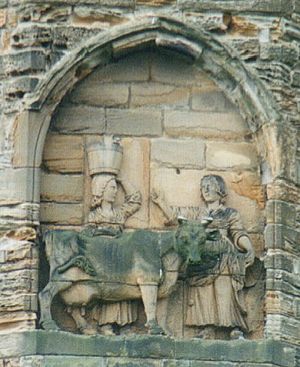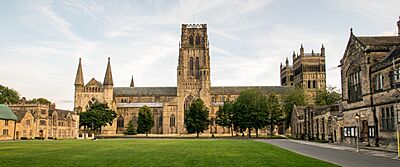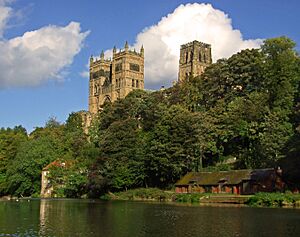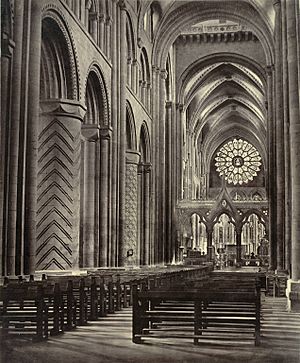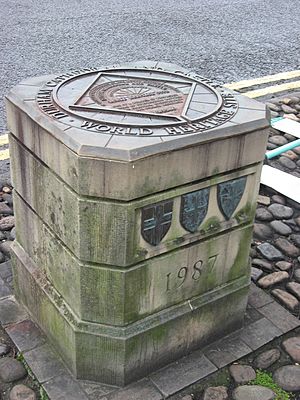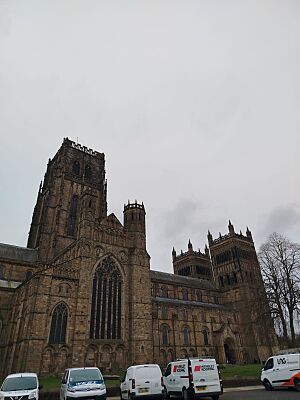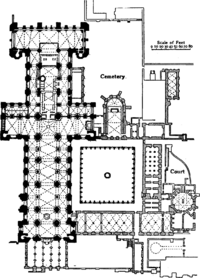Durham Cathedral facts for kids
Quick facts for kids Durham Cathedral |
|
|---|---|
| Cathedral Church of Christ, Blessed Mary the Virgin and St Cuthbert of Durham | |
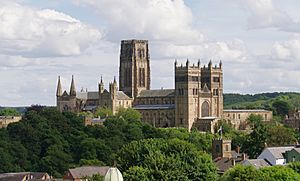
Durham Cathedral from the north-west
|
|
| Lua error in Module:Location_map at line 420: attempt to index field 'wikibase' (a nil value). | |
| Location | Durham |
| Country | England |
| Denomination | Church of England |
| Previous denomination | Roman Catholic |
| Tradition | Broad church |
| History | |
| Status | Cathedral |
| Cult(s) present | Saint Cuthbert & Saint Bede the Venerable |
| Relics held | Saints Cuthbert, Bede & Oswald |
| Architecture | |
| Functional status | Active |
| Heritage designation | Grade I listed |
| Designated | 6 May 1952 |
| Architectural type | Cathedral |
| Style | Norman/Romanesque, Gothic |
| Years built | 1093–1133, additions until 1490 |
| Specifications | |
| Length | 469 feet (143 m) (interior) |
| Nave width | 81 feet (25 m) (incl. aisles) |
| Nave height | 73 feet (22 m) |
| Choir height | 74 feet (23 m) |
| Number of towers | 3 |
| Tower height | 218 feet (66 m) (central tower) 144 feet (44 m) (western towers) |
| Number of spires | 0 (2 on western towers until 1658) |
| Bells | 10 (full circle) |
| Tenor bell weight | 28 long cwt 0 qr 6 lb (3,142 lb or 1,425 kg) |
| Administration | |
| Diocese | Durham (since 635 as Lindisfarne, 995 as Durham) |
| Province | York |
Durham Cathedral, also known as the Cathedral Church of Christ, Blessed Mary the Virgin and St Cuthbert of Durham, is a famous Church of England cathedral in Durham, England. It is the main church for the bishop of Durham and the most important church in the diocese of Durham.
The cathedral is home to the tombs of two important Anglo-Saxon saints: Cuthbert and Bede. Many people visit the cathedral each year, and it holds daily church services. It is a very important historic building, listed as Grade I, and is part of the Durham Castle and Cathedral World Heritage Site.
The cathedral you see today replaced an older church. Its story began with the Lindisfarne Priory, which was started around 635 AD. However, monks had to leave Lindisfarne in 875 because of Viking attacks. They settled in Chester-le-Street from 882 until 995, when they finally moved to Durham.
Durham Cathedral was a monastery until 1541, when it became a church run by a dean and chapter. During the Wars of the Three Kingdoms, about 3,000 Scottish prisoners of war were held in the cathedral, and many of them sadly died there.
The main part of the current building was finished between 1093 and 1133. It is a great example of Romanesque architecture, a style known for its strong, round arches. The ceiling of the nave (the main part of the church) has the earliest known example of a pointed rib vault, which was a very new idea at the time. Over the years, other parts were added, like the Galilee Chapel in the 1170s and the central tower in the 1400s.
The cathedral also has many old and important items, such as the bishop's throne, the Neville screen, and the Prior Castell's Clock. The old monastery buildings are still there, and part of the cathedral library is in the monks' old dining hall. This library has a huge collection of books, some dating back to the 500s!
Contents
History of Durham Cathedral
Early Beginnings: Anglo-Saxon Times
The story of Durham Cathedral began with the Diocese of Lindisfarne, which was founded around 635 AD by Saint Aidan. This was done at the request of Oswald of Northumbria, a king. A very important saint from Lindisfarne was Saint Cuthbert, who was a bishop there from 685 until he died in 687. He is a central figure in the history of Durham Cathedral.
After many Viking raids, the monks had to leave Lindisfarne in 875. They carried Saint Cuthbert's remains with them. They moved around until 882, when they settled in Chester-le-Street, about 60 miles south of Lindisfarne. They stayed there until 995, when more Viking attacks forced them to move again.
According to a local story, the monks followed two milkmaids who were looking for a special cow. They ended up on a piece of land surrounded by a bend in the River Wear. At that spot, Saint Cuthbert's coffin became too heavy to move. The monks took this as a sign that they should build a new church there, and that place became the city of Durham. Another reason for choosing this spot was that it was easy to defend and offered protection from the Earl of Northumbria. Today, a street near the cathedral is called Dun Cow Lane because of this legend.
At first, a simple wooden church was built to hold Saint Cuthbert's remains. This was later replaced by a stronger wooden building, and then by a stone church in 998. This stone church was mostly finished by 1018. Durham quickly became a popular place for pilgrims, people who travel to a holy site. Even King Canute visited and gave many gifts to the monks. The safe location and money from pilgrims helped a town grow around the cathedral, forming the heart of the city.
Building the Norman Cathedral
The current Durham Cathedral was designed and built under William de St-Calais, who became bishop in 1083. He started a Benedictine monastery at Durham and replaced the old church leaders with monks from other monasteries. He divided the church's large lands between his bishopric and the new monastery.
On August 11, 1093, Bishop William and Prior Turgot of Durham laid the first stone of the new, grand cathedral. The monks built their own monastery buildings, while the bishop was in charge of building the cathedral. Stone was cut from nearby cliffs and moved using winches. The main reason for building this huge cathedral was to house the bodies of Saint Cuthbert and the Venerable Bede.
Most of the cathedral you see today is the original Norman structure, even though many changes and additions have been made over time. Building started in 1093 at the eastern end. The choir was finished by 1096. When Bishop William died in 1096, the Chapter House was ready enough for him to be buried there. In 1104, Saint Cuthbert's remains were moved with a big ceremony to the new church.
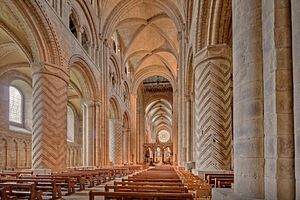
Work continued on the nave, which was finished by 1128, and its high ceiling by 1135. The chapter house was built between 1133 and 1140. Bishop William of St. Calais died before the building was complete, and his successor, Ranulf Flambard, took over. He also built Framwellgate Bridge, the first bridge over the River Wear in the town.
In the 1170s, Bishop Hugh de Puiset added the Galilee Chapel at the west end of the cathedral. This chapel was used as a Lady chapel (a chapel dedicated to the Virgin Mary). The main entrance to the cathedral is now on the north side, facing the castle. The Galilee Chapel also holds the remains of the Venerable Bede.
In 1228, Richard le Poore, who had just rebuilt Salisbury Cathedral in the Gothic style, became Bishop of Durham. The eastern end of Durham Cathedral needed urgent repairs. Bishop Le Poore hired architect Richard Farnham to design a new eastern part for the building, called the Chapel of the Nine Altars. This allowed many monks to pray at the same time. In 1250, the original roof of the cathedral was replaced with a new vaulted ceiling that is still there today.
The cathedral's towers were also built in the early 1200s. However, the central tower was hit by lightning and rebuilt in the 1400s.
Changes Over Time: Dissolution and Restoration
During the English Reformation, King Henry VIII took control of all churches and monasteries that belonged to the Roman Catholic Church. Durham Cathedral became an Anglican church. Saint Cuthbert's tomb was destroyed in 1538 by order of King Henry VIII, and the monastery's wealth went to the king. Saint Cuthbert's body was found to be perfectly preserved and was reburied under a simple stone slab. In 1540, the monastery was officially closed, and the last leader of the monks became the first dean of the cathedral.
After the Battle of Dunbar in 1650, Oliver Cromwell used Durham Cathedral as a prison for Scottish soldiers. About 3,000 prisoners were held there in terrible conditions, and 1,700 died. The prisoners burned much of the cathedral's wooden parts for warmth, but they spared Prior Castell's Clock, which had a Scottish thistle on it. The bodies of the prisoners were buried in unmarked graves.
Bishop John Cosin (who was bishop from 1660 to 1672) worked to repair the damage and add new furniture, like choir stalls and a tall cover over the font. A wooden screen for the organ was also added. A library of old printed books was started in the remains of the old dining hall.
In the 1700s, not much restoration work happened. When work did start again, it wasn't always done carefully. In 1777, an architect named George Nicholson smoothed off much of the cathedral's outer stone, changing its look. Later, in 1794, James Wyatt planned to make big changes, including tearing down the Galilee Chapel, but the church leaders decided against most of his ideas.
In 1829, a special line was engraved on the floor and wall of the north cloister. This "meridian line" allowed a beam of sunlight to show the exact time when the sun was highest in the sky. In the 1800s, architects like Anthony Salvin and George Gilbert Scott worked on restoring different parts of the cathedral, including the cloisters and the central tower. Many beautiful stained glass windows were also added during this time.
Modern Times: 20th and 21st Centuries
In the 1930s, work began to restore Saint Cuthbert's Shrine behind the main altar, making it a special place for worship and pilgrimage. This work continued after World War II. New stained glass windows were added in the 1930s and 1940s, and later ones in the 1980s and 1990s.
In 1986, Durham Cathedral, along with the nearby Durham Castle, became a World Heritage Site. UNESCO described it as "the largest and most perfect monument of 'Norman' style architecture in England." They also noted its importance as a symbol of Norman power and its long history of religious use.
In the 2000s, two altars in the Nine Altars Chapel were rededicated to Saint Hild of Whitby and Saint Margaret of Scotland. A striking painting of Margaret by Paula Rego was added in 2004. A plaque was also placed to remember the Scottish soldiers who died as prisoners in the cathedral after the Battle of Dunbar in 1650. The remains of some of these prisoners were found in a mass grave outside the cathedral in 2013.
In 2016, old monastery buildings around the cloister, like the Monks' Dormitory, were opened to the public as "Open Treasure." This is a large exhibition showing the cathedral's history and treasures. In the same year, a huge model of the cathedral made from 300,000 Lego bricks was completed.
Durham Cathedral has also been featured in the light festival Lumiere, which happens every two years. In 2009, a special light show called "Crown of Light" told the story of Lindisfarne and the cathedral's founding. The cathedral's ancient manuscripts are being digitized by Durham University and Durham Cathedral, making them available to more people. The cathedral and its cloister are open to visitors most days.
Architecture of Durham Cathedral
Durham Cathedral is famous for its amazing architecture. It has some of the earliest examples of rib vaults in England, which are arched ceilings supported by stone ribs. These ribs allowed builders to create taller and wider spaces.
The building is known for the ribbed vault of its nave (the main part of the church). It uses pointed arches supported by strong columns and hidden supports. These features are thought to be early examples of Gothic architecture, which became popular in Northern France. Even though the building is mostly Romanesque, these new ideas made it possible to build much larger and more complex churches.
UNESCO highlights that Durham Cathedral, with its bold vaulting, was an "experimental model" far ahead of its time. They also state that the use of stone ribs forming pointed arches to support the nave ceiling was a major achievement, making Durham Cathedral the earliest known example where the pointed arch was successfully used as a structural element. This was a turning point in architecture because it allowed buildings to be much taller than before.
Saint Cuthbert's tomb is at the east end of the cathedral and was once a very fancy monument of marble and gold. It is still a place where people go to remember him. Pieces of St Cuthbert's coffin are also on display at the cathedral.
Important Burials and Memorials
Durham Cathedral is the resting place for many important people, including several bishops and church leaders. Some notable burials include:
- William de St-Calais, Ranulf Flambard, and Hugh de Puiset, all bishops, are buried in the chapter house.
- The remains of the Venerable Bede are in the Galilee Chapel.
- Thomas Langley, a bishop, is buried in a tomb that once blocked the Great West Door.
There are also memorials to other important figures, such as Bishop Joseph Butler and Bishop Edward Maltby.
Cathedral Leadership and Music
Dean and Chapter
The cathedral is managed by a group called the chapter, led by the dean. The current Dean-Designate is Philip Plyming, who will officially become Dean on September 16, 2023. Other important roles, like the Vice-Dean and Canon Precentor, are chosen by the chapter members each year.
Organ and Organists
The cathedral has a large organ by 'Father' Willis, built in 1876. It has been updated several times since then. The organ cases, designed by C. Hodgson Fowler, are beautifully decorated.
Many talented musicians have served as organists at Durham Cathedral. The current Master of the Choristers and Organist is Daniel Cook, who started in 2017. The Sub-Organist is Joseph Beech.
Choir
Durham Cathedral has a regular choir made up of adult singers and child choristers. The child choristers attend the Chorister School. For a long time, only boys were choristers, but in November 2009, girls were also welcomed into the choir for the first time. The girls and boys sing on different days, but they sometimes sing together for big events like Easter and Christmas.
Bells
The central tower of the cathedral has ten bells that are rung in the English style. Five of these bells are very old, cast in 1693. The other bells were cast later, between 1780 and 1980.
Durham Cathedral in Film and Television
Durham Cathedral has been a popular location for filming movies and TV shows because of its unique Romanesque architecture. It has been used to represent fantasy places in big movies and has also appeared as itself in many television programs.
Movies filmed at the cathedral include:
- Jude (1996)
- Elizabeth (1998)
- The first two Harry Potter films: Philosopher's Stone (2001) and Chamber of Secrets (2002)
- Snow White and the Huntsman (2012)
- Avengers: Endgame (2019)
- The Old Oak (2023)
Television shows filmed at the cathedral include:
- Treasurehunt (1988)
- Songs of Praise
- The Antiques Roadshow
- Britain's Best Buildings (2002)
- Climbing Great Buildings (2010)
- Great British Railway Journeys (2011)
- Richard Wilson: On the Road
- All Man
- Britain's Great Cathedrals
- Two adaptations of books by Catherine Cookson: The Tide of Life and The Wingless Bird.
Art, Literature, and Famous Quotes
Durham Cathedral has inspired many artists and writers. A poem about it by Letitia Landon appeared in a book in 1835.

Many famous people have praised the cathedral:
- Nikolaus Pevsner, a famous art historian, said that Durham, with its Cathedral, Castle, and Monastery, is one of the greatest sights in Europe, like Avignon and Prague. He also described it as a "Romantic dream" and "gigantic, grey, on its own."
- Nathaniel Hawthorne, an American writer, called it "grand, venerable, and sweet, all at once."
- Alec Clifton-Taylor, a TV presenter, said that entering Durham Cathedral is "an architectural experience never to be forgotten."
- Bill Bryson, a popular author, even voted Durham as the "best cathedral on planet Earth."
The writer Walter Scott described Durham Cathedral in his poem Harold the Dauntless as: "Grey towers of Durham Yet well I love thy mixed and massive piles Half church of God, half castle 'gainst the Scot"
This line highlights how the cathedral served both as a place of worship and a strong fortress against attacks from Scotland.
See also
 In Spanish: Catedral de Durham para niños
In Spanish: Catedral de Durham para niños
- Gothic cathedrals and churches
- English Gothic architecture
- Architecture of the medieval cathedrals of England
- Palace Green


